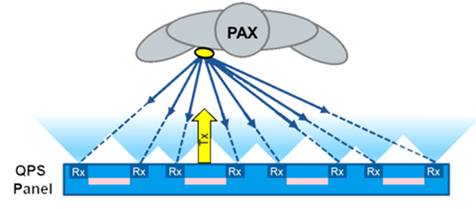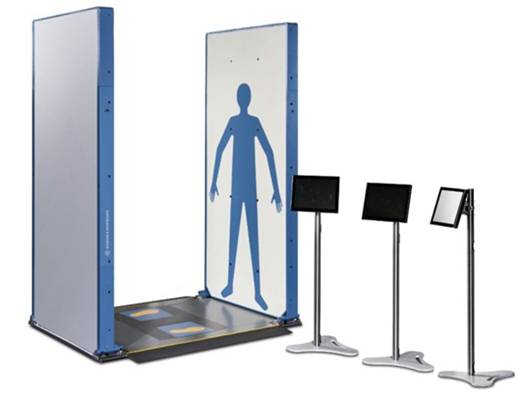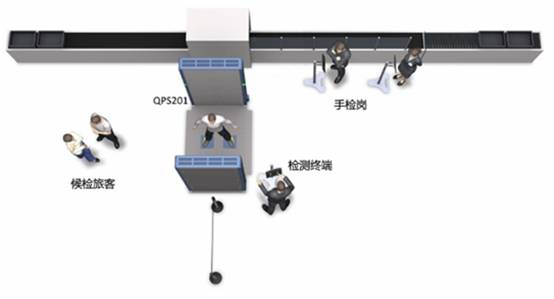
Non-contact millimeter wave security detector, a powerful weapon for new crown virus detection
“Under the increasingly stable situation of the new crown pneumonia epidemic, all units across the country are faced with the safe resumption of work and the transportation of returning workers. For the security inspection department, how to ensure the security inspection of the transportation industry and key units after the resumption of work during the epidemic prevention and control stage, while avoiding the risk of infection at work as much as possible, has become the focus of prevention.
“
Under the increasingly stable situation of the new crown pneumonia epidemic, all units across the country are faced with the safe resumption of work and the transportation of returning workers. For the security inspection department, how to ensure the security inspection of the transportation industry and key units after the resumption of work during the epidemic prevention and control stage, while avoiding the risk of infection at work as much as possible, has become the focus of prevention.
The novel coronavirus is usually spread by coughing and sneezing, close contact with an infected person or touching an infected surface, and secondarily through the mouth, nose or eyes. In order to reduce the risk of infection, when people go to public places, in addition to wearing masks, they should also minimize contact with public items and parts in public places, reduce contact with others, and keep a certain distance from others as much as possible. Due to the large number of daily contacts, security personnel have a greater risk of infection than the general population, so they should pay more attention to the protection of new coronavirus infection. In addition to wearing masks and other protective equipment during the work period, daily cleaning and disinfection should also be done. Because they may come into contact with passengers or their belongings, security personnel should pay special attention to hand hygiene, usually wash their hands with hand sanitizer or running water, and measure their body temperature at least twice a day. If you have suspicious symptoms such as fever, cough, difficulty breathing, diarrhea, vomiting, muscle aches, etc., you should stop work immediately, seek medical attention in time, and not work while sick.
In order to prevent the carrying of prohibited items that endanger public safety, the current security check method widely used in airports and stations is to let passengers pass through the metal detection security gate first, and if the security gate alarms, they need to undergo manual inspection. Metal detection security gates can detect metal objects carried by passengers. However, the disadvantages of this method are also obvious: on the one hand, only metal objects can be detected, but objects made of ceramics, plastics, liquids and other materials have no ability to identify, and will leak. Drop non-metallic contraband, so it may need to be supplemented by manual inspection; on the other hand, metal detection security gates will alarm but cannot Display the shape and exact hiding location of the item, and do not have the ability to identify the item – such as a harmless coin or a prohibited item Blades – possible, objects can only be located and identified by subsequent manual inspection. In fact, almost every passenger has metal objects such as belt buckles. The N95 masks worn by passengers also contain aluminum-plastic strips, and some passengers have metal implants in their bodies. The existence of all kinds of metal objects that are carried with you makes the metal detection security gates basically call the police, and almost 100% of them still need to be checked by hand. During manual security checks, security personnel need to be in close contact with passengers, which increases the risk of infection due to droplets and close contact. The millimeter wave human body security detector introduced in this article can detect metal and non-metal prohibited objects and accurately display their shapes and hiding positions, which is convenient for identifying objects, thereby greatly reducing the frequency of manual inspections, reducing the risk of infection, and protecting the health of security personnel. .
There are two types of millimeter-wave human security detectors, active and passive. The working principle of the former is similar to that of radar. The device first radiates millimeter waves to the human body, and then detects the millimeter waves reflected by the human body through the receiver, thereby imaging the human body. The latter does not actively radiate, but only realizes imaging by detecting the millimeter-wave radiation of the target itself. In comparison, active millimeter-wave systems have higher resolution, better imaging effects, and stronger environmental adaptability. They are not affected by temperature, sunlight, and surrounding radiation sources, so they are widely used in the security inspection industry. The following are all active millimeter-wave human body security detectors.
The resolution of the millimeter-wave human body security detector is related to the operating frequency. The higher the operating frequency, the shorter the wavelength and the higher the resolution, but the cost of the device will also increase. Rohde & Schwarz’s R&S®QPS201 millimeter-wave body security detector uses electromagnetic wave signals in the 70-80GHz frequency band, and the resolution can reach 2mm. For devices using low-frequency signals, the detection resolution is limited by wavelength. For example, a 38GHz signal can only detect 5mm objects. The safety of electromagnetic radiation to the human body is an important consideration in the design of radio frequency microwave equipment. Millimeter wave body security detectors are very safe for the human body. First, the millimeter wave signal can only be reflected by the body surface and will not penetrate the human body. Second, the transmitting power of the millimeter wave human body security detector is very low, so it is very safe. Taking the R&S®QPS201 as an example, its transmit power is less than one thousandth of that of a mobile phone, and its duration is only a few tens of milliseconds. Therefore, its electromagnetic radiation is very low, which fully complies with the electromagnetic environment standards of various countries in the world.
When the active millimeter wave human body security detector radiates millimeter waves to the human body, there are two implementations: full Electronic scanning and electronic plus mechanical scanning. The antenna array of the former is a two-dimensional large-scale antenna array composed of thousands of antennas. The scanning method Two-dimensional scanning is performed in an all-electronic manner, and the representative products are the German R&S®QPS series. The latter antenna array is a one-dimensional electronically scanned antenna array composed of a small number of antennas, and then two-dimensional scanning is achieved by mechanically moving the one-dimensional antenna array. The representative product is ProVision from L3 in the United States. Due to the use of a two-dimensional large-scale antenna array, the cost of all-electronic scanning is relatively high, but it brings three advantages: First, the response speed of the circuit is much higher than that of moving parts. Click-to-scan, no mechanical start-stop process; secondly, without mechanical moving parts, the work stability is greatly improved, the risk of failure is greatly reduced, and regular calibration is not required; finally, maintenance is extremely simple and convenient. The antenna array is a mosaic structure of module arrangement. When the module fails, it only needs to be replaced and inserted into the spare module. It takes only a few minutes, and the local maintenance personnel can directly operate it after training. The working principle of the fully electronically scanned millimeter-wave body security detector is shown in Figure 1. The two-dimensional antenna array of the instrument (QPS Panel in Figure 1) transmits millimeter wave signals to the human body in turn from the transmitting antennas, which are reflected back to the panel by the body surface of the inspector (PAX in Figure 1). All the receiving antennas of the antenna array measure the signal distribution at the same time, and the massive data obtained from all scans are transferred to the signal processing unit and the computer to perform relevant imaging operations and restore the body surface characteristics of the examinee. According to the reflectivity of the object, the shape and reflection intensity of the object are calculated. Recognition aided by artificial intelligence algorithms to find independent objects that are not part of the human body. Finally, the position and shape of the suspicious object are marked on the schematic diagram of the human body (as shown in Figure 2). The image will not show the details of the human body to respect personal privacy. If remote manual discrimination is performed on the basis of machine artificial intelligence, suspicious objects can be further identified.

Figure 1. In a test, the transmit antennas transmit one by one, while the receive antennas all work simultaneously each time.Guaranteed efficient and high-precision detection

Figure 2. Detection results are displayed on a schematic diagram of the human body to protect privacy
With the advancement of radio frequency technology and the improvement of computer system integration capabilities, the application and promotion of millimeter-wave human body security inspection instruments has become a new trend in the industry. This instrument is suitable for security inspections in airports and key units. The advantage is that it has a high effective detection rate and thus can greatly reduce the frequency of manual inspection. First of all, the range of detection items is greatly increased, which can detect both metal objects and non-metal objects such as plastics, ceramics, and liquids. Secondly, it can accurately display the shape of the object and the hidden position, and display the shape and position of the target object on the screen in front of the security personnel in the form of a schematic diagram of the human body. If the passenger does not hide prohibited items, he/she can be allowed to pass directly without manual inspection; if there is hidden prohibited items, the security personnel only need to check the hiding of the objects in the relevant body parts according to the schematic diagram without the need for a full-body inspection. Therefore, it can greatly reduce the contact probability of hand inspection, and significantly reduce the risk of infection while improving the efficiency of security inspection. This article takes Rohde & Schwarz’s QPS201 as an example to introduce the application of millimeter-wave human body security checker in the field of security check. Rohde & Schwarz was founded in Munich, Germany in 1933. Its products are specialized in radio frequency microwave and millimeter wave. It has a rich foundation in the communication, military, aviation, and airport industries, and has always maintained a leading position in the industry. In the current technological frontier: microwave imaging and intelligent identification, Rohde & Schwarz has experience in designing high-precision measurement solutions, and unique high-efficiency algorithm software and hardware systems. R&S®QPS series products have been used in passenger security check areas of dozens of large and medium-sized airports in Europe and America, as well as security check posts in some key units. In China, the R&S®QPS201 has been certified by the Civil Aviation Administration of China for security inspection equipment, and is already being deployed to domestic airports.

Figure 3 The R&S®QPS201 mmWave body security checker used at Munich Airport in Germany replaces the traditional metal detection security gate
The core component of the R&S®QPS201 millimeter-wave human security scanner is two measuring panels with a height of 2.3 meters and a width of 1.1 meters. The two panels are separated by 1.5 meters to form a spacious and open measurement channel, which is beneficial to people with claustrophobia. . Each panel contains thousands of transceiver units and miniature antennas, forming a large-scale antenna array, and built-in fast data processing units and high-performance computers for control, processing and imaging. The overall design is highly integrated, stable and reliable. The system provides two kinds of display terminals: the main display terminal can be operated and displayed by the operator, and is generally placed near the security inspection instrument; the auxiliary terminal can be selected and placed flexibly. The inspector provides prompts, as shown in Figure 4.

Figure 4 R&S®QPS201 mmWave human security scanner
In terms of the space placement of the instrument, the operator and the passenger can keep a distance without close contact (as shown in Figure 3); the hand-check display terminal can be placed arbitrarily within the length of the network cable. Both the distance between passengers and the distance between passengers and security personnel are guaranteed. How it works: Passengers stand naturally facing the main panel according to the portrait prompts on the instrument, with their feet and hands slightly separated. The operator clicks the start button, and the scan is completed in just 64 milliseconds, accompanied by a “ding” prompt. The inspected passengers can leave the inspection area when they hear the sound. The instrument quickly revealed the detection results, including the number of suspicious items and where they were hiding. At this time, the operator guides the passengers according to the test results: if the security check is passed, the passengers are requested to go directly through the security check area; some passengers are prompted that there are suspicious objects, and the passengers are requested to go to the hand check position for inspection. In the hand inspection area, the hand inspection personnel will check the corresponding body parts of the passengers according to the terminal prompts. Because there are already part reminders, the purpose of hand inspection is clearer and the contact time is shorter. It can be seen from the working mechanism of the instrument that during the security check:
Passengers can wear masks to pass through the millimeter-wave security inspection device, even if there are metal aluminum strips on the masks;
●The operator should keep a sufficient distance from the passengers during the inspection by the security checker;
The detection results of the security inspection instrument are highly accurate, which can greatly reduce the probability of inspection by hand inspection;
●Manual inspection
The purpose of the bit inspection is clear and the inspection time is shortened. The above four characteristics obviously help reduce the probability of infection and prevent and control the spread of the epidemic. In practical application scenarios, after product iteration, the R&S®QPS201 has an optimized detection channel design, which reserves a variety of convenient conditions for efficient security inspection:
●R&S®QPS201 is a fixed channel design, there are no moving parts such as cantilever in the instrument, and the work is stable and easy to maintain.
●The internal passage space is spacious enough, and it has good passability for passengers who have passed the inspection; otherwise, the security personnel will not block the view. In emergencies or special circumstances, stranded passengers (such as disabled persons) can be allowed to pass through the apparatus and directly arrange hand inspection.
●Simple site requirements, no need to reserve surrounding space. 2 meters wide channel can be installed. Isolation piles can be placed next to the instrument, or multiple groups of instruments can be installed adjacent to each other.

Figure 5. Post arrangement of security check channel using R&S®QPS201
Figure 6 Schematic diagram of the security inspection channel, the security inspector has a good visual distance
In terms of system integration and maintenance, R&S®QPS201 supports network bus integration interface, can report working status and statistical data in time, and has a proprietary management software system. With no moving parts, the instrument does not require routine calibration. Calibration is only required after on-site repairs, about 40 minutes. The entire process is fully automated, requires no special equipment, and can be operated by specially trained personnel. Finally, in the after-sales service system, Rohde & Schwarz has service organizations in many major cities across the country. Rohde & Schwarz has established a complete set of rapid response mechanism to implement hierarchical handling of product problems, and can also implement training and maintenance through local partners, enabling rapid response and efficient solutions to global products.
The Links: FF200R12KS4 LC171W03-A4KD


